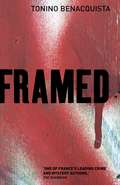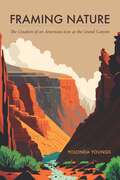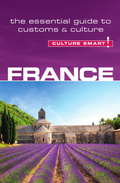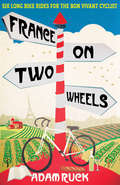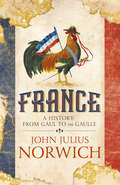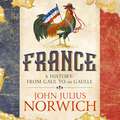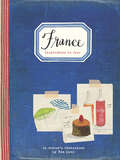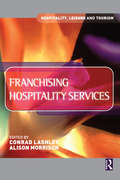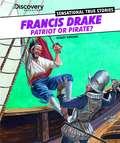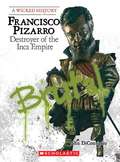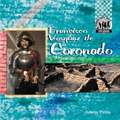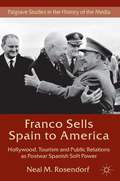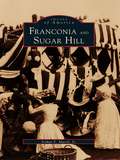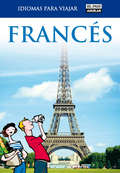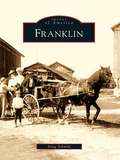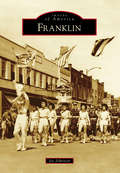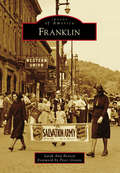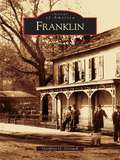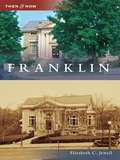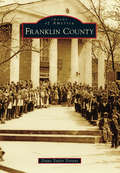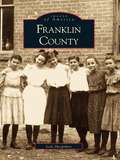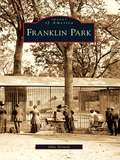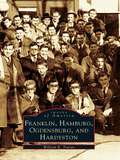- Table View
- List View
Framed
by Adriana Hunter Tonino BenacquistaAntoine, a fanatic billiards player, is asked to watch over a Paris art gallery. When he scuffles with a thief a statue falls and severs his right hand. His maverick investigation leads to the discovery of a series of gruesome killings. Soon Antoine finds himself the prime suspect in the murder of a gallery owner. A game of billiards decides the outcome of this satirical tale which brilliantly captures the world of modern art and the parasites that infest it. After being, in turn, a museum night-watchman, and a train guard on the Paris-Rome line, Tonino Benacquista is now a highly successful author of fiction and film scripts.
Framing Nature: The Creation of an American Icon at the Grand Canyon (America’s Public Lands)
by Yolonda YoungsThe Grand Canyon of the Colorado River is an internationally known feature of the North American landscape, attracting more than five million visitors each year. A deep cultural, visual, and social history has shaped the Grand Canyon&’s environment into one of America&’s most significant representations of nature. Yet the canyon is more than a vacation destination, a movie backdrop, or a scenic viewpoint; it is a real place as well as an abstraction easily summoned in the minds of Americans. The Grand Canyon, or the idea of it, is woven into the fabric of American cultural identity and serves as a cultural reference point—an icon. In Framing Nature Yolonda Youngs traces the idea of the Grand Canyon as an icon and the ways people came to know it through popular imagery and visual media. She analyzes and interprets more than fourteen hundred visual artifacts, including postcards, maps, magazine illustrations, and photographs of the Grand Canyon, supplemented with the words and ideas of writers, artists, explorers, and other media makers from 1869 to 2022. Youngs considers the manipulation and commodification of visual representations and shifting ideas, values, and meanings of nature, exploring the interplay between humans and their environments and how visual representations shape popular ideas and meanings about national parks and the American West. Framing Nature provides a novel interpretation of how places, especially national parks, are transformed into national and environmental symbols.
France - Culture Smart!
by Barry TomalinCulture Smart! provides essential information on attitudes, beliefs and behavior in different countries, ensuring that you arrive at your destination aware of basic manners, common courtesies, and sensitive issues. These concise guides tell you what to expect, how to behave, and how to establish a rapport with your hosts. This inside knowledge will enable you to steer clear of embarrassing gaffes and mistakes, feel confident in unfamiliar situations, and develop trust, friendships, and successful business relationships.Culture Smart! offers illuminating insights into the culture and society of a particular country. It will help you to turn your visit-whether on business or for pleasure-into a memorable and enriching experience. Contents include* customs, values, and traditions* historical, religious, and political background* life at home* leisure, social, and cultural life* eating and drinking* do's, don'ts, and taboos* business practices* communication, spoken and unspoken"Culture Smart has come to the rescue of hapless travellers." Sunday Times Travel"... the perfect introduction to the weird, wonderful and downright odd quirks and customs of various countries." Global Travel"...full of fascinating-as well as common-sense-tips to help you avoid embarrassing faux pas." Observer"...as useful as they are entertaining." Easyjet Magazine"...offer glimpses into the psyche of a faraway world." New York Times
France in Mind: An Anthology
by Alice Leccese PowersIn her third literary Baedeker, Alice Leccese Powers-editor of Italy in Mind and Ireland in Mind-explores France through the senses and sensibilities of thirty-three British and American authors.The food and the people, the culture and viniculture, the architecture and the expatriates, the pleasures (and frustrations) of France are described by intrepid travelers who also happen to be brilliant essayists, poets, and novelists. From Gertrude Stein's Paris to Ezra Pound's Pyrenees; from Tobias Smollett, who grumbled, to Peter Mayle, who settled in; and from Edith Wharton on falling in love to David Sedaris on falling over French grammar-here is France in all its splendor in the words of some of the best and most entertaining writers in the English language. Henry Adams * James Baldwin * Elizabeth Bishop * Mary Blume * James Fenimore Cooper * Charles Dickens * Lawrence Durrell * Lawrence Ferlinghetti * M. F. K. Fisher * F. Scott Fitzgerald * Janet Flanner * Adam Gopnik * Joanne Harris * Ernest Hemingway * Washington Irving * Henry James * Thomas Jefferson * Stanley Karnow * Peter Mayle * Mary McCarthy * Jan Morris * Ezra Pound * David Sedaris * Tobias Smollett * Gertrude Stein * Robert Louis Stevenson * Paul Theroux * Gillian Tindall * Calvin Trillin * Mark Twain * Edith Wharton * Richard Wilbur * William Carlos WilliamsFrom the Trade Paperback edition.
France on Two Wheels: Six Long Bike Rides For The Bon Vivant Cyclist
by Adam RuckBoth a practical companion and a story of exploration and rediscovery, France on Two Wheels offers detailed descriptions of useful routes, stop-off points and watering-holes, along with detours into subjects as varied as wine, windmills, Wodehouse, and beer. It is vivid proof that the only way to experience the French countryside is on a bike.Adding insight to anecdote, this book is packed with practical tips: on rail travel with a bicycle, mending a puncture in French, and the best stopovers along the route - small hotels, B&Bs and chateaux, every one "a cultural treasure worth celebrating".
France on Two Wheels: Six Long Bike Rides For The Bon Vivant Cyclist
by Adam RuckBoth a practical companion and a story of exploration and rediscovery, France on Two Wheels offers detailed descriptions of useful routes, stop-off points and watering-holes, along with detours into subjects as varied as wine, windmills, Wodehouse, and beer. It is vivid proof that the only way to experience the French countryside is on a bike.Adding insight to anecdote, this book is packed with practical tips: on rail travel with a bicycle, mending a puncture in French, and the best stopovers along the route - small hotels, B&Bs and chateaux, every one "a cultural treasure worth celebrating".
France: A History: from Gaul to de Gaulle
by John Julius Norwich'For his final book, the late Norwich tackled the dauntingly vast subject of two millennia of French history with admirable lightness and urbanity . . . his comic footnotes deserve a review of their own' DAILY TELEGRAPHI can still feel, as if it were yesterday, the excitement of my first Channel crossing (as a child of nearly 7) in September 1936; the regiment of porters, smelling asphyxiatingly of garlic in their blue-green blousons; the raucous sound all around me of spoken French; the immense fields of Normandy strangely devoid of hedges; then the Gare du Nord at twilight, the policemen with their képis and their little snow-white batons; and my first sight of the Eiffel Tower . . . This book is written in the belief that the average English-speaking man or woman has remarkably little knowledge of French history. We may know a bit about Napoleon or Joan of Arc or Louis XIV, but for most of us that's about it. In my own three schools we were taught only about the battles we won: Crécy and Poitiers, Agincourt and Waterloo. The rest was silence. So here is my attempt to fill in the blanks . . .John Julius Norwich's last book is the book he always wanted to write: the extremely colourful story of the country he loves best. From frowning Roman generals and belligerent Gallic chieftains, to Charlemagne (hated by generations of French children taught that he invented schools) through Marie Antoinette and the storming of the Bastille to Vichy, the Resistance and beyond, FRANCE is packed with heroes and villains, adventures and battles, romance and revolution. Full of memorable stories and racy anecdotes, this is the perfect introduction to the country that has inspired the rest of the world to live, dress, eat -- and love better.
France: A History: from Gaul to de Gaulle
by John Julius NorwichA witty history of 2000 years of French history from legendary popular historian John Julius NorwichI can still feel, as if it were yesterday, the excitement of my first Channel crossing (as a child of nearly 7) in September 1936; the regiment of porters, smelling asphyxiatingly of garlic in their blue-green blousons; the raucous sound all around me of spoken French; the immense fields of Normandy strangely devoid of hedges; then the Gare du Nord at twilight, the policemen with their képis and their little snow-white batons; and my first sight of the Eiffel Tower...This book is written in the belief that the average English-speaking man or woman has remarkably little knowledge of French history. We may know a bit about Napoleon or Joan of Arc or Louis XIV, but for most of us that's about it. In my own three schools we were taught only about the battles we won: Crécy and Poitiers, Agincourt and Waterloo. The rest was silence. So here is my attempt to fill in the blanks...John Julius Norwich (at 88) has finally written the book he always wanted to write, the extremely colourful story of the country he loves best. From frowning Roman generals and belligerent Gallic chieftains, to Charlemagne (hated by generations of French children taught that he invented schools) through Marie Antoinette and the storming of the Bastille to Vichy, the Resistance and beyond, FRANCE is packed with heroes and villains, adventures and battles, romance and revolution. Full of memorable stories and racy anecdotes, this is the perfect introduction to the country that has inspired the rest of the world to live, dress, eat -- and love better.(P)2018 Hodder & Stoughton Limited
France: Inspiration du Jour
by Rae DunnBrimming with joie de vivre, France provides a glimpse into the gorgeous sketchbooks that artist Rae Dunn compiles during her annual sojourns in Paris, Provence, and the French Riviera. Colors, tastes, and smells come to life with each turn of the page, as Dunn's charming watercolor sketches and dreamy photographs beautifully depict the cityscapes, landscapes, foods, and pastimes that epitomize the romance of France. Additionally, hand-lettered notes reveal Dunn's inspirations as an artist. Francophiles, armchair travelers, and art lovers alike will rejoice in this thoughtful celebration of this beloved region's myriad everyday pleasures.
Franchising Hospitality Services (Hospitality, Leisure, And Tourism Ser.)
by Conrad Lashley Alison Morrison'Franchising in the Hospitality Industry' provides an overview of the issues, debates and challenges associated with business franchising. In two parts, this text firstly looks at the issues from both an academic and practitioner perspective. The second part looks more closely at service sector groups in the hospitality industry, such as hotels, leisure and catering using national and international examples and illustrations. These demonstrate how the theories and debates discussed in the first part, are tackled in real life situations. Examples used are from well known companies such as McDonalds, Baskin Robbins, Burger King, Choice Hotels, Holiday Inn, Domino Pizza, Pierre Victoire amongst others.
Francis Drake: Patriot or Pirate? (Discovery Education: Sensational True Stories)
by Robert SheehanFrancis Drake was a man some considered a hero, while others thought he was nothing more than a criminal. Readers will decide for themselves in this fact-filled volume. Easy-to-follow text and colorful illustrations will keep any young readers interest.
Francisco Pizarro: Destroyer of the Inca Empire
by John DiconsiglioBiography of Francisco Pizarro and his effects on the Inca Empire, for teens.
Francisco Vasquez de Coronado
by Kristin PetrieThis text traces the life of Francisco Vasquez de Coronado, who led a major expedition from Mexico through what is now the southwestern United States.
Franco Sells Spain to America
by Neal M. RosendorfA groundbreaking study of the Franco regime's utilization of Hollywood film production in Spain, American tourism, and sophisticated public relations programs - including the most popular national pavilion at the 1964-65 New York World's Fair - in a determined effort to remake the Spanish dictatorship's post-World War II reputation in the US.
Franconia and Sugar Hill (Images of America)
by Arthur F. March Jr.Although geographically contiguous and linked by their shared industries of early iron works and latertourism, Franconia and Sugar Hill are unique areas with distinct personalities that have developed over the years. The discovery of rich deposits of iron ore in Sugar Hill in the late 1700s and the establishment of iron works in Franconia brought the two areas together in a working partnership. The coming of the railroads brought tourism into both communities, with Franconia supplying the scenery with its mountains and far-famed Franconia Notch, and Sugar Hill rounding out the scenery with a generous offering of grand summer hotels. The sharing of the summer tourist industry was greatlybroadened by the development of skiing in the early part of the present century. Again, Franconia provided the major terrain and Sugar Hill provided many of the guest accommodations, including the first formal ski school at the prestigious Peckett's Inn. With all of its attributes, the area has attracted a number of notables, including movie star Bette Davis.
Francés (Idiomas para viajar #Volumen)
by El País-AguilarLas guías de idiomas que rompen barreras lingüísticas Idiomas para viajar. Francés ofrece ahora unos contenidos mucho más amplios y completos. Cada guía recoge todo lo que se necesita para desenvolverse durante el viaje: una guía de pronunciación, un resumen gramatical y un manual básico del idioma como introducción a todos los bloques temáticos pensados para resolver situaciones según avanza el viaje (llegada, desplazamientos, alojamiento, restaurantes, ocio, compras, salud, emergencias...). Todos los capítulos tienen, además de introducciones prácticas del país, un vocabulario imprescindible y expresiones habituales, con sus correspondientes transcripciones. La guía concluye con un nuevo diccionario bilingüe, que contiene todas las palabras de uso habitual en la comunicación diaria.
Franklin
by Doug SchmidtFranklin is a microcosm of how a sparsely populated farming community may progress into a small city. German and Irish settlers established Franklin's earliest business enterprises--taverns, blacksmiths, farm supply stores, and the annual Labor Day fair, which remains the largest of its kind in Milwaukee County. In 1956, Franklin moved from a township to a city, featuring a single patrolman and an all-volunteer fire department. For entertainment, Franklinites availed themselves of the 41 Twin Outdoor Theater or Saturday night races at Hales Corner Speedway, Little League diamonds in St. Martins or behind the fire station, and dance halls at Heiden's or the White Dove. A new era began when Franklin High School opened its doors to 350 students in 1962. Today, at 36 square miles--Milwaukee's largest suburb--it is noteworthy that Franklin still has room for a functioning stone quarry and the Tuckaway Country Club.
Franklin
by Joe JohnstonStudents of the Civil War know Franklin, Tennessee, for the major battle that happened here, but there is a lot more to the story. In fact, Main Street in Franklin is a glimpse into 250 years of history. Within a few blocks surrounding the public square, some of the city's original buildings now house the newest and most popular shops, restaurants, and entertainment venues in Middle Tennessee. Franklin has been a center for agriculture and manufacturing. It is a place where families can enjoy small-town life on the interstate. It is home to a college. It has always been the seat of Williamson County. Franklin's small businesses have a habit of sticking around for decades, often passing through generations of the same family. Franklin is as quaint and picturesque as it is exciting and progressive, because it continues to attract the kind of people who have always made it that way.
Franklin
by Peter Greene Sarah Ann BentonOn December 4, 1753, Gen. George Washington traveled to the junction of the Allegheny River and French Creek during one of his military excursions. There, the settlement was called Venango but soon became known as Franklin. Established in the heart of the original oil country in the 1740s, Franklin is the seat of Venango County. Once referred to as "the Nursery of Great Men," it boasts a rich history of industry and railroads. Franklin's historic district, listed in the National Register of Historic Places, includes businesses that have been staples in the city for over 100 years, such as Feldman Jewelers and Anderson Furniture. Today, Franklin takes great pride in its history and heritage. Franklin's annual Applefest, the largest craft festival in western Pennsylvania, honors the travels of Johnny Appleseed, who planted his trees throughout the town during his journeys, and the bridge that spans the confluence of the Allegheny and French Creek is still known as Washington Crossing.
Franklin (Images of America)
by Geoffrey G. GorsuchFranklin was first established in 1796 as a sleepy collection of cabins along the beautiful Great Miami River. When the Miami Canal came through the village in 1829, and the railroad followed in the 1870s, many new industries came to the area, and the downtown filled with fine brick and stone residences, businesses, churches, and public buildings. The town prospered through the 19th century, and the proud community's leaders proclaimed a grand celebration of its past, present, and envisioned future: the FranklinHomecoming of 1910. Just three years later, Franklin was struck by the greatest calamity in its history, the Flood of 1913. Though Franklin quickly recovered, it soon left its past behind, as it became a modern city in a rapidly changing nation. Through vintage images of buildings, businesses, and people now gone and forgotten, Franklin brings to life the town's rich history, from its beginnings to 1920.
Franklin (Then and Now)
by Elizabeth C. JewellFranklin, incorporated in 1895, is New Hampshire's smallest city and is situated where the Pemigewasset and Winnipesaukee Rivers form the headwaters of the Merrimack River. Long known as the "Gateway to the White Mountains," Franklin was once a thriving tourist destination and a bustling mill town. These deep and varied roots inspired resident Elizabeth C. Jewell to document the city's development. Franklin continues to look towards the future and remains respectful of its past.
Franklin County
by Diane Taylor TorrentFranklin County is situated in the northeastern Piedmont region of North Carolina. Known for its fruitful soil, rolling hills, and bountiful streams, it has a rich agricultural heritage. Franklin County was created in 1779, with its founders honoring statesman Benjamin Franklin as the county's namesake. Built along the Tar River, Louisburg, the county seat, has an impressive historic district lined with majestic homes and churches from the turn of the 20th century. Steeped in education, Franklin County is home to Louisburg College, which was established in 1787, and once boasted as many as 100 one-room schoolhouses. Franklin County showcases the architectural heritage, long-standing communities, and citizens who have lived and worked here.
Franklin County
by Lola ShropshireCreated from a portion of Crawford County in 1837, Franklin County is divided by the Arkansas River into two sections, each with its own county seat: Ozark in the North and Charleston in the South. Northern Franklin County is remote, mysterious, and beautiful, while the southern area enjoys graceful and vastly productive prairie lands. The combination of fertile soil and mild climate in the Ozark Mountains produces fruit, vineyards, precious stones, granite, and forests. Evocative images such as the young girls posing in the Altus schoolyard paint a poignant and revealing picture of everyday life in Franklin County. Coal mining played a large part in the lives of residents, and photographs of soot-covered miners display the hardships of this difficult work. With over two hundred photographs gathered from local collections, this book illustrates the history and culture of Franklin County in vivid detail, with captions that are both entertaining and informative.
Franklin Park
by Julie ArrisonFranklin Park was meant to be the crown jewel of the Emerald Necklace, Boston's famed park system. It was also meant to be the epitome of Frederick Law Olmsted's distinguished career as the father of American landscape architecture. Its 527 acres of open space have been a salvation from urban plight and also the center of urban controversy. Today the community around the park remains strong and depends upon the work of volunteers, advocacy groups, and the City of Boston. The photographs in Franklin Park have been collected from a variety of personal collections and public archives in an effort to illustrate the park's history from its inception in the 1880s through its rebirth in the 1990s.
Franklin, Hamburg, Ogdensburg, and Hardyston: A View Of Sparta, Franklin, Hamburg, Ogdensburg, And Hardyston (Images of America)
by William R. TruranFranklin, Hamburg, Ogdensburg, and Hardyston chronicles the settlement and life of the Wallkill Valley area of northern New Jersey. In rare photographs, the book reveals the history of the people and places in the communities of Franklin, Hamburg, Ogdensburg, and Hardyston. Beginning entirely as Hardyston Township, the area developed into four communities, each with distinctive qualities. Franklin is the "Fluorescent Mineral Capital of the World," as declared by the U.S. Congress, and with its zinc mines, is known as the "Model Mining Town of America." Hamburg from early times was a crossroads and business district. Ogdensburg possessed several mines and Thomas Edison interests. Hardyston, with its lakes for summer visitors and still-thriving farmland, retains the beauty of its natural surroundings.
